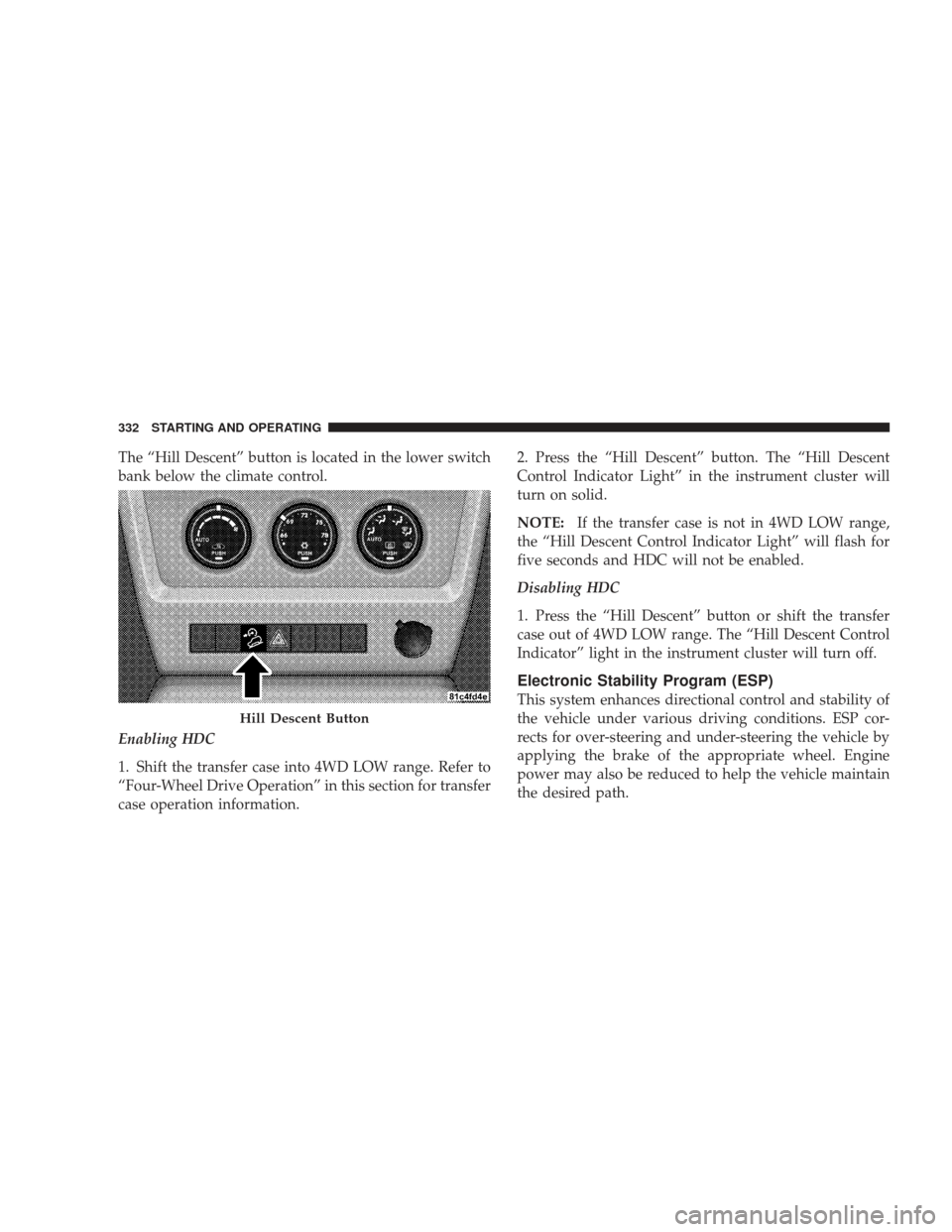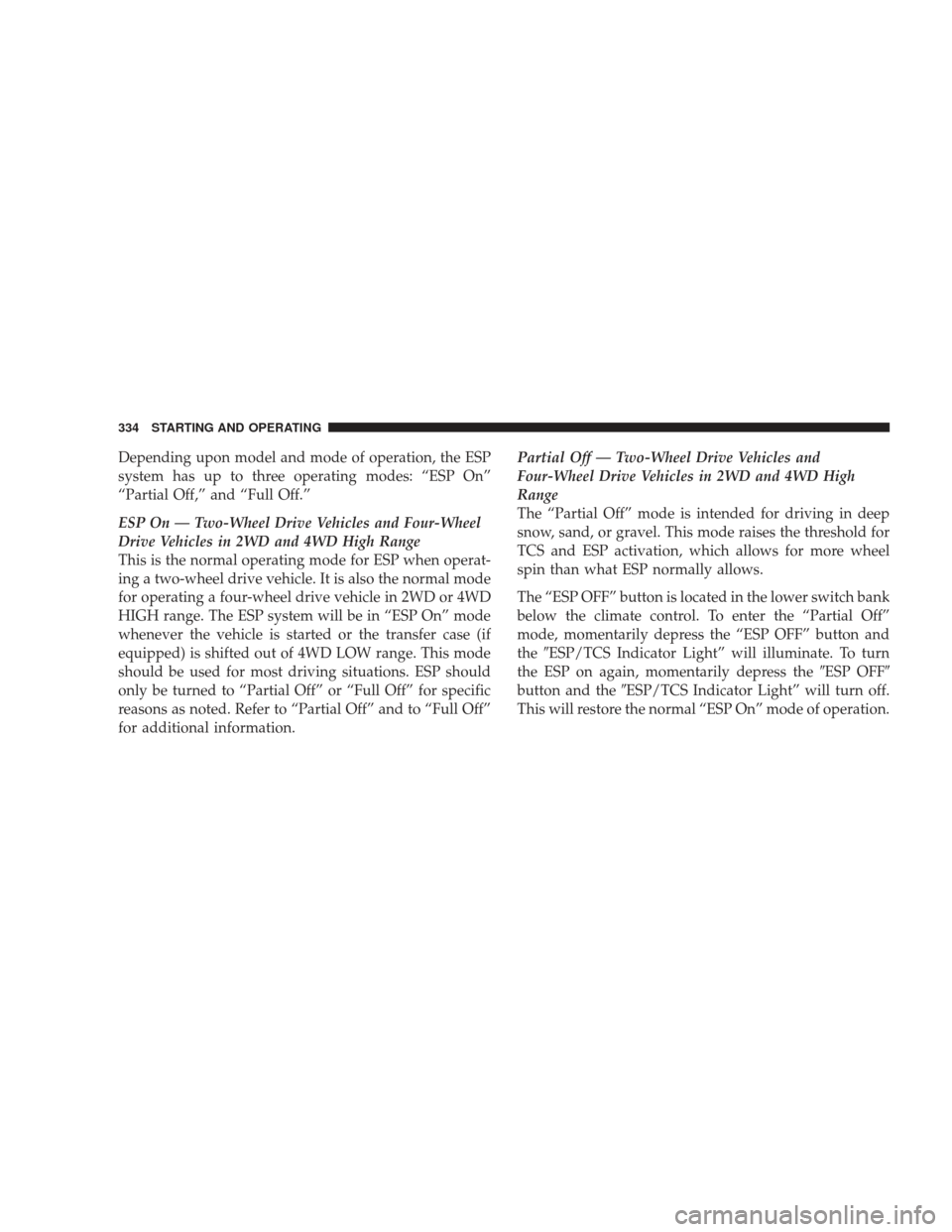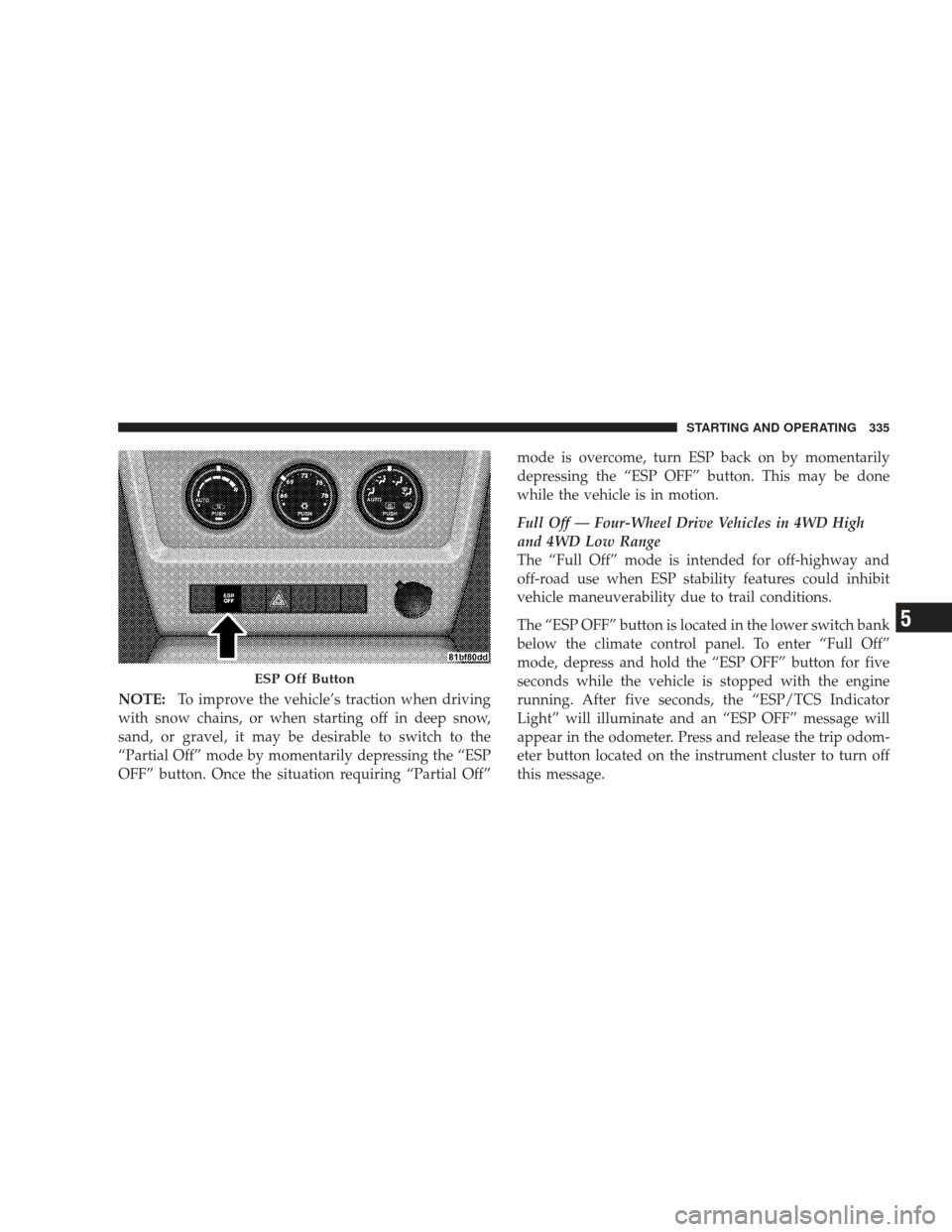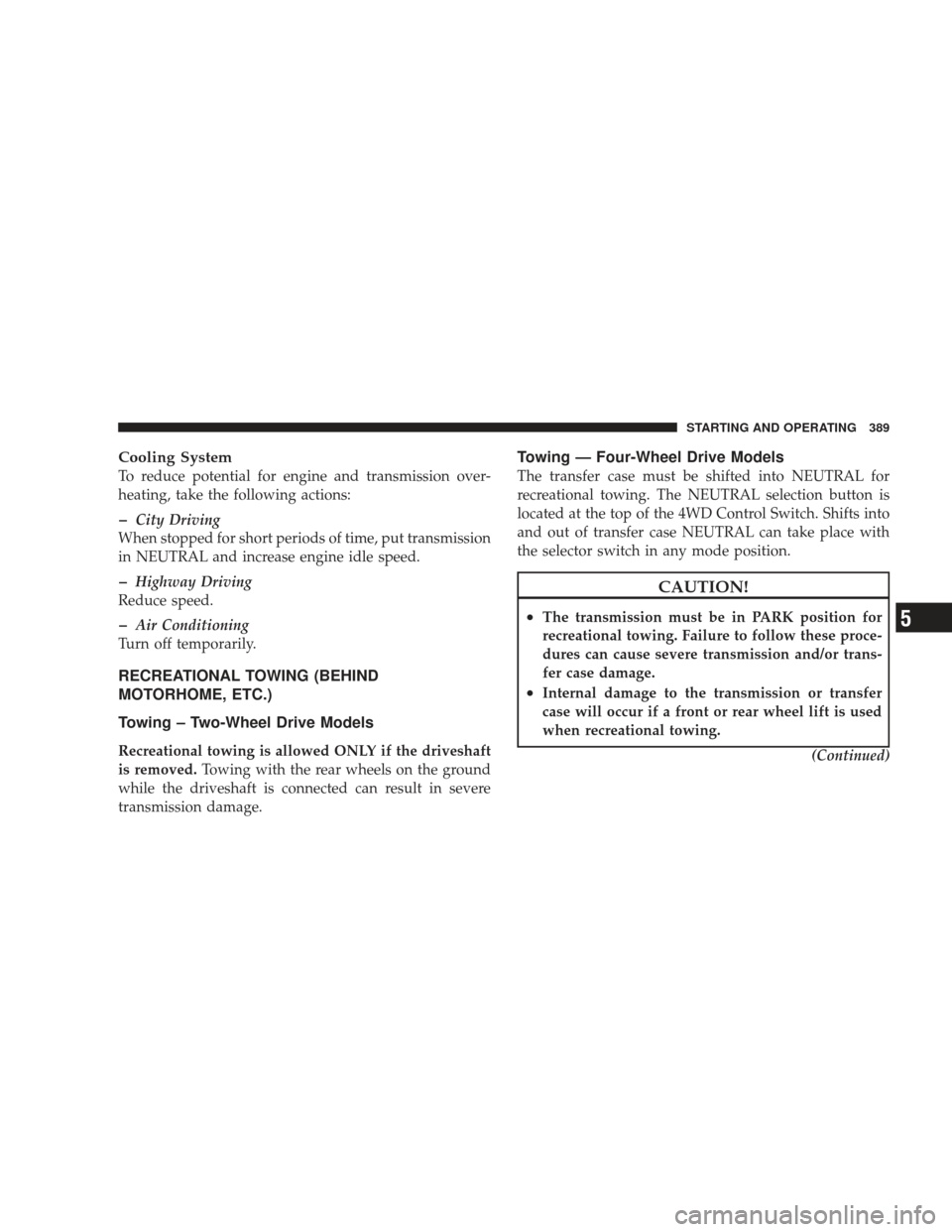Page 334 of 506

The “Hill Descent” button is located in the lower switch
bank below the climate control.
Enabling HDC
1. Shift the transfer case into 4WD LOW range. Refer to
“Four-Wheel Drive Operation” in this section for transfer
case operation information.2. Press the “Hill Descent” button. The “Hill Descent
Control Indicator Light” in the instrument cluster will
turn on solid.
NOTE:
If the transfer case is not in 4WD LOW range,
the “Hill Descent Control Indicator Light” will flash for
five seconds and HDC will not be enabled.
Disabling HDC
1. Press the “Hill Descent” button or shift the transfer
case out of 4WD LOW range. The “Hill Descent Control
Indicator” light in the instrument cluster will turn off.
Electronic Stability Program (ESP)
This system enhances directional control and stability of
the vehicle under various driving conditions. ESP cor-
rects for over-steering and under-steering the vehicle by
applying the brake of the appropriate wheel. Engine
power may also be reduced to help the vehicle maintain
the desired path.
Hill Descent Button
332 STARTING AND OPERATING
Page 336 of 506

Depending upon model and mode of operation, the ESP
system has up to three operating modes: “ESP On”
“Partial Off,” and “Full Off.”
ESP On — Two-Wheel Drive Vehicles and Four-Wheel
Drive Vehicles in 2WD and 4WD High Range
This is the normal operating mode for ESP when operat-
ing a two-wheel drive vehicle. It is also the normal mode
for operating a four-wheel drive vehicle in 2WD or 4WD
HIGH range. The ESP system will be in “ESP On” mode
whenever the vehicle is started or the transfer case (if
equipped) is shifted out of 4WD LOW range. This mode
should be used for most driving situations. ESP should
only be turned to “Partial Off” or “Full Off” for specific
reasons as noted. Refer to “Partial Off” and to “Full Off”
for additional information.Partial Off — Two-Wheel Drive Vehicles and
Four-Wheel Drive Vehicles in 2WD and 4WD High
Range
The “Partial Off” mode is intended for driving in deep
snow, sand, or gravel. This mode raises the threshold for
TCS and ESP activation, which allows for more wheel
spin than what ESP normally allows.
The “ESP OFF” button is located in the lower switch bank
below the climate control. To enter the “Partial Off”
mode, momentarily depress the “ESP OFF” button and
the
�ESP/TCS Indicator Light” will illuminate. To turn
the ESP on again, momentarily depress the �ESP OFF�
button and the �ESP/TCS Indicator Light” will turn off.
This will restore the normal “ESP On” mode of operation.
334 STARTING AND OPERATING
Page 337 of 506

NOTE:To improve the vehicle’s traction when driving
with snow chains, or when starting off in deep snow,
sand, or gravel, it may be desirable to switch to the
“Partial Off” mode by momentarily depressing the “ESP
OFF” button. Once the situation requiring “Partial Off” mode is overcome, turn ESP back on by momentarily
depressing the “ESP OFF” button. This may be done
while the vehicle is in motion.
Full Off — Four-Wheel Drive Vehicles in 4WD High
and 4WD Low Range
The “Full Off” mode is intended for off-highway and
off-road use when ESP stability features could inhibit
vehicle maneuverability due to trail conditions.
The “ESP OFF” button is located in the lower switch bank
below the climate control panel. To enter “Full Off”
mode, depress and hold the “ESP OFF” button for five
seconds while the vehicle is stopped with the engine
running. After five seconds, the “ESP/TCS Indicator
Light” will illuminate and an “ESP OFF” message will
appear in the odometer. Press and release the trip odom-
eter button located on the instrument cluster to turn off
this message.
ESP Off Button
STARTING AND OPERATING 335
5
Page 360 of 506

NOTE:
•The TPMS is not intended to replace normal tire care
and maintenance, or to provide warning of a tire
failure or condition.
•The TPMS should not be used as a tire pressure gauge
while adjusting your tire pressure.
•Driving on a significantly under-inflated tire causes
the tire to overheat and can lead to tire failure.
Under-inflation also reduces fuel efficiency and tire
tread life, and may affect the vehicle’s handling and
stopping ability.
•The TPMS is not a substitute for proper tire mainte-
nance, and it is the driver ’s responsibility to maintain
correct tire pressure using an accurate tire pressure
gauge, even if under-inflation has not reached the
level to trigger illumination of the Tire Pressure Moni-
toring Telltale Light.
•Seasonal temperature changes will affect tire pressure,
and the TPMS will monitor the actual tire pressure in
the tire.
Base System
The Tire Pressure Monitor System (TPMS) uses wireless
technology with wheel rim mounted electronic sensors to
monitor tire pressure levels. Sensors, mounted to each
wheel as part of the valve stem, transmit tire pressure
readings to the receiver module.
NOTE:It is particularly important for you to check the
tire pressure in all of the tires on your vehicle monthly
and to maintain the proper pressure.
The TPMS consists of the following components:
•Receiver Module
•Four Tire Pressure Monitoring Sensors
•Tire Pressure Monitoring Telltale Light
358 STARTING AND OPERATING
Page 361 of 506

The matching full-size spare wheel and tire assembly (if
equipped) has a tire pressure monitoring sensor. The
matching full-size spare can be used in place of any of the
four road tires. The TPMS will only monitor the pressure
in the full-size spare when it is used in place of a road
tire. Otherwise, a spare with a pressure below the low-
pressure limit will not cause the Tire Pressure Monitoring
Telltale Light to illuminate or the chime to sound.
Tire Pressure Monitoring Low Pressure Warnings
The Tire Pressure Monitoring Telltale Light will
illuminate in the instrument cluster and a chime
will sound when tire pressure is low in one or
more of the four active road tires. Should this occur, you
should stop as soon as possible, check the inflation
pressure of each tire on your vehicle, and inflate each tire
to the vehicle’s recommended cold placard pressure
value. Once the system receives the updated tire pres-
sures, the system will automatically update and the Tire
Pressure Monitoring Telltale Light will turn off. The vehicle may need to be driven for up to 20 minutes above
15 mph (25 km/h) in order for the TPMS to receive this
information.
Check TPMS Warning
When a system fault is detected, the Tire Pressure Moni-
toring Telltale Light will flash on and off for 75 seconds
and then remain on solid. The system fault will also
sound a chime. If the ignition key is cycled, this sequence
will repeat, providing the system fault still exists. The
Tire Pressure Monitoring Telltale Light will turn off when
the fault condition no longer exists. A system fault can
occur due to any of the following:
1. Jamming due to electronic devices or driving next to
facilities emitting the same radio frequencies as the TPMS
sensors.
2. Installing some form of aftermarket window tinting
that affects radio wave signals.
STARTING AND OPERATING 359
5
Page 363 of 506

Telltale Light will turn off, as long as no tire pressure is
below the low-pressure warning limit in any of the four
active road tires. The vehicle may need to be driven for
up to 20 minutes above 15 mph (25 km/h) in order for the
TPMS to receive this information.
Premium System — If Equipped
The Tire Pressure Monitor System (TPMS) uses wireless
technology with wheel rim mounted electronic sensors to
monitor tire pressure levels. Sensors, mounted to each
wheel as part of the valve stem, transmit tire pressure
readings to the receiver module.
NOTE:It is particularly important for you to check the
tire pressure in all of the tires on your vehicle monthly
and to maintain the proper pressure.
The TPMS consists of the following components:
•Receiver Module
•Four Tire Pressure Monitoring Sensors
•Three Trigger Modules (mounted in three of the four
wheel-wells)
•Various Tire Pressure Monitoring System messages,
which display in the Electronic Vehicle Information
Center (EVIC)
•Tire Pressure Monitoring Telltale Light
The matching full size spare wheel and tire assembly (if
equipped) has a tire pressure monitoring sensor. The full
size spare can be used in place of any of the four road
tires. A spare with a pressure below the low-pressure
limit will not cause the Tire Pressure Monitoring Telltale
Light to illuminate or the chime to sound. However, it
will cause a “SPARE LOW PRESSURE” message to
display in the EVIC.
STARTING AND OPERATING 361
5
Page 391 of 506

Cooling System
To reduce potential for engine and transmission over-
heating, take the following actions:
�City Driving
When stopped for short periods of time, put transmission
in NEUTRAL and increase engine idle speed.
�Highway Driving
Reduce speed.
�Air Conditioning
Turn off temporarily.
RECREATIONAL TOWING (BEHIND
MOTORHOME, ETC.)
Towing – Two-Wheel Drive Models
Recreational towing is allowed ONLY if the driveshaft
is removed. Towing with the rear wheels on the ground
while the driveshaft is connected can result in severe
transmission damage.
Towing — Four-Wheel Drive Models
The transfer case must be shifted into NEUTRAL for
recreational towing. The NEUTRAL selection button is
located at the top of the 4WD Control Switch. Shifts into
and out of transfer case NEUTRAL can take place with
the selector switch in any mode position.
CAUTION!
•The transmission must be in PARK position for
recreational towing. Failure to follow these proce-
dures can cause severe transmission and/or trans-
fer case damage.
•Internal damage to the transmission or transfer
case will occur if a front or rear wheel lift is used
when recreational towing.
(Continued)
STARTING AND OPERATING 389
5
Page 407 of 506
TOWING METHODS
NOTE:
When towing a 4x4 model, the transfer case must be in NEUTRAL and the transmission must be in PARK.
Model Flat Towing (all four wheels ON theground) Flatbed Towing
(Recommended Method) Front Wheels
Raised, Rear Wheels on the Ground Rear Wheels Raised,
Front Wheels on the Ground
2 Wheel Drive Rear driveshaft must be removedAll four wheels sus-
pended OFF the
groundSpeed less then
30 mph (48 km/h)
and distance less
than 15 miles (24 km)Speed less then
30 mph (48 km/h)
and distance less
than 15 miles (24 km)
4 Wheel Drive Transfer case must be in Neutral and trans-
mission must be in
PARKAll four wheels sus-
pended OFF the
ground
NOT Permitted NOT Permitted
WHAT TO DO IN EMERGENCIES 405
6